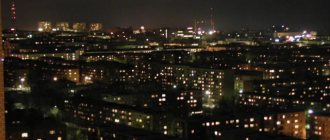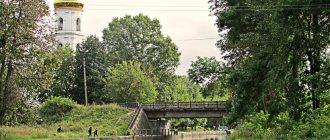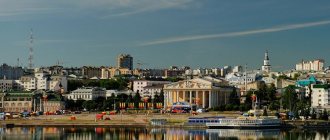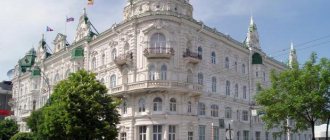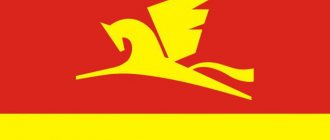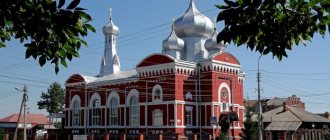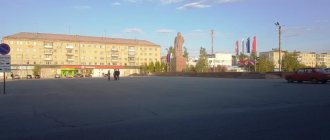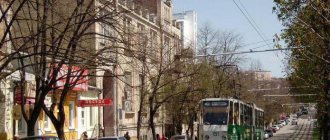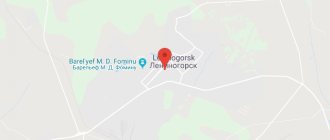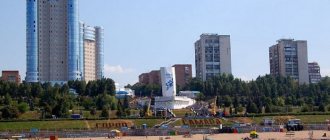Izhevsk is the administrative center of Udmurtia and is considered one of the largest industrial cities in the Volga region and the Urals. Izhevsk was founded in 1760, when the construction of the Izhevsk ironworks, a dam and a settlement on the banks of the Izh River began. Until 1918, it was called the Izhevsk plant. At the end of the Soviet empire, for three years he bore the name Ustinov.
In 1807, major changes occurred in the development of the city. On the site of the ironworks, which was seriously damaged after the attack by Emelyan Pugachev in 1774, an arms factory was founded. Thanks to this, today Izhevsk is considered one of the two weapons capitals of Russia. In the city in 1948, industrial production of the most famous and popular small arms in the world, the Kalashnikov assault rifle, began. Izhevsk has the title of cultural capital of the Volga region (2004), the most comfortable urban settlement in the country (2010), and city of labor glory (2011). In 1979 he was awarded the Order of the October Revolution.
The main elements of the coat of arms and flag of the city of Izhevsk are unclenched pincers, a vertical arrow, a shield and rowan branches with berries. They personify the trinity of nature, man and production activity. City Day in Izhevsk is celebrated on June 12 (established by the City Charter).
Natural living conditions
Izhevsk is located in the East of the East European Plain, on the Izh River, between the Kama and Vyatka rivers.
The city has an artificial reservoir (pond) with an area of 2.2 thousand hectares.
Time zone - plus 1 hour relative to Moscow time.
The climate here is temperate continental, its main parameters are as follows:
- average annual temperature - plus 3 Cº;
- seasonal soil freezing - 1.7 m;
- the average temperature of the coldest month (January) is minus 12.4 Cº;
- the average temperature of the hottest month (July) is plus 19 Cº;
- absolute temperature minimum - minus 47.5 Cº;
- absolute temperature maximum - plus 37 Cº,
- annual precipitation is 511 mm.
Typically, the temperature in the city is 0.6-0.8 Cº higher than in its suburbs. Most days of the year southwest winds blow in Izhevsk, although strong gusty winds, storms and hurricanes are rare. The most precipitation usually falls in August (67 mm). The city is located on a hilly plain, on three watershed areas.
Short story
On the territory of Izhevsk, archaeologists have discovered traces of ancient settlements, the age of which is estimated at 1800 years. From 1438 to 1552, the land on which the capital of Udmurtia later appeared belonged to the Kazan Khanate. After the capture of Kazan by the troops of Ivan IV in 1552, the Udmurt region became part of Russia. The further history of Izhevsk is marked by several fateful events:
- from 1582, the territory where the city appeared much later belonged to the Tatar volost;
- in 1734, iron ore deposits were discovered here;
- April 1760 - construction of the Izhevsk plant and the village around the enterprise began;
- 1763 – construction of a dam on the Izh River and the formation of the Izhevsk pond;
- 1774 - the plant was looted by rebels under the leadership of E. Pugachev;
- 1807 – the founding of an arms factory took place;
- XIX century - rapid development of production;
- February 1918 - the village received city status and began to be called Izhevsk;
- December 1934 - the city was given the status of the capital of an autonomous republic;
- 1940–1988 – a period of rapid development of industry in the city and expansion of its territory; 17 nearby towns and villages were annexed to Izhevsk;
- September 2010 – ceremonial events were held in the capital of Udmurtia on the occasion of the 250th anniversary of the city.
Now Izhevsk is a large industrial center, home to over 90 nationalities. The largest peoples in number are Russians (69%), Tatars (9%) and Udmurts (15%).
Ecology of Izhevsk
The environmental situation in Izhevsk is not fundamentally different from other industrial cities in the country. The total volume of emissions into the atmosphere from stationary sources in the republic in recent years is 172 thousand tons. At the same time, emissions of pollutants from road transport amount to about 140 thousand tons. According to data from the traffic police, the increase in emissions from cars will increase; in 2013 alone, the number of cars increased by 3.4%.
Thanks to environmental measures in the city and the republic, the amount of captured and neutralized pollution from stationary sources is increasing (almost 4 times in 2013). The volume of discharge of poorly treated wastewater is reduced. Unauthorized landfills have a negative impact on the city's ecology, especially if they burn. In this case, they are a source of dioxides and sulfur dioxide.
Flag
The flag of Izhevsk is made in the form of a rectangular panel. It is divided into two parts vertically: azure and white. Aspect ratio – 1:2. They depict elements of the city's coat of arms. Their width is 1/4 of the length of the flag, their height is 1/3 of its length.
The artistic composition was approved on April 21, 2000 and entered into the State Heraldic Register of the Russian Federation under No. 631.
Population of Izhevsk
In 2015, the number of residents of the republican capital is estimated at 642 thousand people. The dynamics of the city's population growth since its founding are as follows:
- 1760 - 200 people;
- 1780 - 2 thousand people;
- 1917 - 40 thousand people;
- 1939 - 176 thousand people;
- 1970 - 422 thousand people;
- 1991 - 647 thousand people;
- 2015 - 642 thousand people.
In terms of population, Izhevsk is one of the twenty largest cities in the country. More than 42% of the region's residents are concentrated there. There is also an agglomeration in which more than 950 thousand people live. The share of the Russian population in the administrative center of the subject is 68.8%. The number of Udmurts and Tatars is significant, 14.8% and 8.9%, respectively. The share of other nationalities does not exceed 7.5%. In general, the number of nationalities exceeds a hundred.
Popular message topics
- Animals of Antarctica
Antarctica is a territory with harsh climatic conditions. The temperature of the mainland is very low, and the entire territory is covered with thick ice. Despite such conditions, there is a variety of flora and fauna here, which surprises us with its - Kostroma: Golden Ring of Russia
Russia is a great, beautiful country! It is rich in the diversity and beauty of its nature, countless mineral reserves, monuments of ancient and modern architecture and art, and unforgettable tourist routes. - The city of Mytishchi
Mytishchi is one of the cities in the Moscow region, located on the Yauza River. The distance to the center of the capital from Mytishchi does not exceed 20 km in the northeast direction. The city's close proximity to Moscow makes it unusually
Famous people
The lives of many famous people are connected with Izhevsk, but, of course, the most famous of them is Mikhail Kalashnikov. His brainchild, the machine gun of the same name, can even be seen on the flags of a number of countries. Among other celebrities of the city and the republic, the following personalities can be noted:
- Pyotr Shuvalov, count, founder of the city, famous statesman of the country;
- Grigory Vereshchagin, ethnographer;
- Vladimir Korolenko, famous human rights activist;
- Dmitry Zelenin, ethnographer;
- Hermann Weber, motorcycle designer;
- Alexander Belyanin, full Knight of St. George;
- Hugo Schmeisser, small arms designer;
- Ivan Bodalev, merchant, builder and philanthropist;
- Gennady Nikonov, weapons designer;
- Lyudmila Glazova, actress;
- Valery Medvedtsev, biathlete, Olympic champion;
- Anton Sychev, swimmer;
- Ivan Tcherezov, biathlete;
- Maria Gorban, actress.
Izhevsk is the pride of Russian industry
The capital of the Republic of Udmurtia received the status of an urban settlement only after the October Revolution, in 1918. However, during these decades a huge leap forward was made both in terms of industrial and cultural development. The assignment of the status of a city of labor glory was a natural result of all the processes that took place here throughout the twentieth century.
The population of the city of Izhevsk is famous for its traditions in various fields of culture, science, education and, of course, for its production successes, talent, hard work and creative approach to any business. The capital of Udmurtia is a multinational city. At the same time, he is an example for all other cities and regions of our country of how Russians and Udmurts, Mordovians and Tatars, Ukrainians and Jews can get along well and cooperate fruitfully.
Economy of the region and the city of Izhevsk
It is believed that Udmurtia has the largest concentration of enterprises in the military-industrial complex. Industry and diversified agricultural production are developed in the republic. The region also has oil reserves, which are being extracted and processed. There is a powerful energy complex, consisting mainly of thermal power plants. In the north and west of the republic, logging is carried out; there are enterprises for wood processing, production of furniture and house-building structures. A nuclear industry enterprise is located in Glazov.
Izhevsk itself is known for its developed mechanical engineering and the production of high-quality steel. The city produces weapons and military equipment, small arms (hunting and rifled weapons), instrument making and the food processing industry. Industry employs 31.7% of the city's working population. The city has a low unemployment rate; at the beginning of 2015 it was 0.71%. There are branches of federal-level banks here, and there are foreign financial institutions.
The city's retail network consists of 2,300 retail outlets, 438 catering establishments and four markets. The leading positions are occupied by large chain stores of federal-level companies (Lenta, Auchan, Eldorado, etc.). There are 31 socially oriented trading enterprises. There are 21 fairs for the sale of agricultural products on an ongoing basis. Online stores are actively operating in the city market, offering a full range of consumer goods. The hotel business is well developed (52 hotels).
Izhevsk is considered a major transport hub, located at the intersection of air, rail and road routes. Buses, trolleybuses, and trams run around the city. There is an intra-city water bus.
Geography
The territory in which Izhevsk is located is a flat area with low hills scattered across it. The capital of Udmurtia stretches for 27.4 km from south to north and 17.4 km from east to west. On the territory of Izhevsk – 315.5 sq. km – three cities such as Tver or Tula can fit. The capital of Udmurtia is approximately 6.5 times smaller than Moscow.
Izh, a tributary of the Kama, divides Izhevsk into two almost equal parts. The city lives according to Samara time, which is one hour ahead of Moscow. The capital of Udmurtia includes 5 urban districts. Its location in the Volga region has a beneficial effect on the economic development of the city. The republic, of which Izhevsk became the capital in 1934, borders on four constituent entities of the Russian Federation:
- with the Perm region;
- Tatarstan;
- Kirov region;
- Bashkortostan
Investments
Izhevsk is a steadily developing city, so a lot of investment projects are being implemented here in various fields of activity:
- residential construction (mainly multi-family housing);
- construction of a plant for the production of cable joints;
- reconstruction of sections of heating mains;
- reconstruction of overhead power lines;
- modernization of facilities to create production of the LADA2191 car;
- creation of production of springs with increased service life;
- expansion of steel radiator production;
- increasing the production of sporting and hunting weapons;
- creation of specialized production of gyroscopes;
- creation of lines for the production of insulating tapes and acrylic adhesive tapes;
- creation of production for anodizing aluminum profiles.
In addition, there are a number of projects that could be implemented if additional funding is found:
- expansion of paint and varnish production;
- creation of the Scientific and Production Center “Cryogenic Technologies”;
- low-rise microdistrict;
- creation of a biotesting and biomonitoring laboratory;
- remediation of solid waste landfill;
- creation of production of light-emitting diodes;
- technical re-equipment of the boiler room.
Main denominations
Izhevsk, whose population is not only multinational, but also multi-religious, is one of the most striking examples of religious tolerance in Russia.
The largest religious community in the city is the Orthodox, and in Izhevsk itself the residence of the Metropolitan of Izhevsk and Udmurt has long been located, whose place is currently occupied by Metropolitan Nikolai.
The second largest community is Muslims. The first mosque appeared in the city during the times of the empire. Currently, there are three similar institutions operating here, in addition, the Regional Spiritual Administration of Muslims conducts educational activities in the city.
In addition to the two main ones, representatives of such religious movements as Buddhists, Protestants, Old Believers, and Mormons operate quite successfully in Izhevsk.
Enterprises of Izhevsk
OJSC Concern Kalashnikov is a diversified joint-stock company, the main activities of which are the manufacture and testing of small arms (combat, sports, hunting), guided high-precision projectiles for artillery, guns for aviation, machine tools, tools and test mechanisms. In the near future, the company plans to release branded clothing of the same name. The number of employees is more than 4.5 thousand people.
OJSC Izhevsk Mechanical Plant produces 86% of all small arms in the country (civilian and service), packaging and oil and gas equipment, precision steel castings, medical equipment (pacemakers), electrical tools, automobile compressors. The number of employees is more than 7 thousand people.
LLC Poultry Farm Varaksino is the 4th poultry farm in Russia and the largest egg producer in Udmurtia. This is a closed-cycle factory, covering all stages from incubation to finished products. The volume of production, including branches, is 663 million eggs per year.
OJSC Izhevsk Electromechanical is a defense industry enterprise, part of the Almaz-Antey concern. Manufactures and services the Saman-M1 target complex and the Tor-M2E air defense system. The civil sector is represented by various climate control equipment.
OJSC Izhevsk Moto produces special equipment for military needs, radio relay, satellite and operational communications equipment, energy-saving equipment, parts and components for cars.
Factors that positively influence the demographic situation in Izhevsk
As mentioned above, the population of the city of Izhevsk has been steadily growing in the last four cities. This growth, of course, is not as impressive as that observed in the second half of the 1980s, but after constant negative indicators for 20 years since 1993, this trend looks very encouraging. The main factors that influenced such a drastic change in the situation are as follows.
Firstly, there is a significant increase in the birth rate. It is connected both with natural processes (the generation of the 80s began to give birth) and with the efforts of the state (maternity capital, regional housing programs for young families).
Secondly, the number of people entering the city constantly exceeds the number of residents leaving it.
Finally, thirdly, the economic stability that established in the region in the 2000s also played an important role in the positive dynamics of population growth.
Construction in Izhevsk
The central object of the city, shaping the appearance of the city, is Izhevsky Pond. The capital of the republic itself is essentially a factory city. Izhevsk is developing not only through the construction of new districts, but also by improving the quality of life and the level of infrastructure of existing territories. In particular, over the past few years, a new Cherry Square has been organized, the area around the city administration has been landscaped, and there is a project for a park for cyclists.
A roundabout on Liebknecht and Pushkinskaya streets was built. Work is underway to develop the concept of the Central Square.
There are plans for large-scale development of housing complexes. In 2019 alone, about 315 thousand square meters of housing were commissioned. These are mainly apartment buildings, accounting for about 88% of the built area. The main ways of development of the capital of the republic today are:
- development of a central architectural ensemble along the main directions to the south, north and east with the construction of business and (or) public centers;
- continuation of the formation of construction sites in the center;
- reconstruction and improvement of meridional and latitudinal streets;
- restoration of cultural heritage buildings;
- transfer of transit traffic beyond the borders of Izhevsk;
- changes in the purpose of industrial areas for residential and public development;
- systemic improvement and development of the Izhevsky Pond area;
City information
Izhevsk is the capital of the Udmurt Republic. Located between the Vyatka and Kama rivers. The economy is represented by enterprises of the metallurgical, mechanical engineering, and defense industries.
Regional roads pass through the settlement: P320, P321, P322, and the European route E22. A major highway of the Gorky Railway runs through it. There is an airport of the same name.
There are universities and their representative offices, professional and secondary specialized educational institutions. There are cultural institutions and attractions. The population is about 650 thousand people.
Cost of new buildings
Depending on the area, number of storeys, material and class of construction, the cost on the primary market of Izhevsk ranges from 50 to 60 thousand rubles per square meter.
Let's consider the average sale price depending on the number of rooms
- A one-room apartment will cost residents of Izhevsk around 2,296,634 rubles;
- A two-room apartment can be found for RUB 3,274,192;
- The cost of a three-room apartment ranges from 4,664,424 rubles.
Since most of the residential real estate put into operation belongs to the economy class, we bring to your attention the average market prices for the city districts. For convenience, we will arrange the areas in ascending order of price per square meter in a new building:
- Leninsky District offers apartments with an average price of 50 thousand rubles per square meter. The cheapness is due to the presence of a large number of industrial enterprises.
- Pervomaisky district is filled with housing costing from 55 thousand rubles per 1 m2. This price order can be found in all six residential neighborhoods.
- Ustinovsky district is a densely populated area. Its territory is the smallest in area among all the districts. Despite the dense development and the smallest amount of green territory, the average cost per square meter in a new building does not fall below 56 thousand rubles.
- The Industrial District finishes with the highest price in January for 1 m2 at 58 thousand rubles
Sex and age structure
The population of Izhevsk can be considered as a kind of cross-section, giving an idea of the gender and age structure of the population throughout Russia. Thus, according to data at the beginning of this year, the total number of men in the city is just over forty percent, while the percentage of women is close to sixty.
The picture is not very happy if we look at the age structure of the city’s population. Despite the fact that in recent years the number of both men and women, albeit not at a very high rate, has been growing, the percentage of the working-age population in the overall structure of residents of this urban population has continued to decline. Moreover, this trend is likely to continue in the coming years. The thing is that people born in the 1950s and 1960s are gradually retiring, but very few are replacing them. This is due to the difficult situation in the country in the 1990s, when there was a real demographic crisis.
City districts
Initially, in 1934, there were three districts in Izhevsk. As a result of decisions made by regional authorities, the administrative division has undergone various changes over the years. Their result is the division of the settlement into five districts:
- Ustinovsky (137 thousand people);
- Oktyabrsky (136 thousand people);
- Pervomaisky (126 thousand people);
- Leninsky (125 thousand people);
- Industrial (119 thousand people).
According to 2015 data, the Ustinovsky district is considered the largest in terms of the number of inhabitants, the most densely populated and at the same time the smallest in area (24.3 sq. km). This is due to the dense development of apartment buildings and the small area of green areas. Formed in 1987.
Along the border of the two largest districts of the city, Leninsky (130 sq. km) and Oktyabrsky (87.8 sq. km), is Izhevsky Pond. The territory of the current Leninsky district is the place where the construction of an ironworks and dam began in 1760. It is considered the historical center of Izhevsk. The formation of the Industrial District is mainly associated with the creation. Mechanical engineering, food and light industry, and trade are developed in the Pervomaisky district.
Izhevsk
Video: Izhevsk
Basic moments
Izhevsk from a bird's eye view
Izhevsk stands between the Kama and Vyatka, on the Izh River, which divides it into two parts. The city is located 1200 km from Moscow and lives according to Samara time. The day comes here an hour earlier than in the capital of Russia. Streets and houses were built on a hilly plain, and the features of the relief were reflected in the old names of Izhevsk districts and streets - Gorka, Malinovaya Gora, Nagorny and Zareka. The highest place of the Udmurt capital is in the Eastern village (208 m), and the southern part of the urban area lies in the lowlands.
The historical center of Izhevsk was formed around former state-owned factories. You can come here by different types of public transport, but the most convenient way to do this is by tram number 11. The main architectural monuments and museums of the city are associated with the production of small arms. This is a monument to Izhevsk gunsmiths, a museum of the history of OJSC Izhmash, as well as a museum and exhibition complex of small arms, which bears the name of Mikhail Timofeevich Kalashnikov.
Monument to Izhevsk gunsmiths
Monument to Peoples' Friendship
The city has many beautiful temples, unusual monuments, interesting museums and pleasant green areas for walking. Tourists who come here try to take away weapons-themed souvenirs as a souvenir of their stay in Izhevsk. Patterned woolen socks and mittens, dolls in national Udmurt costumes and paintings by local artists are also popular among travelers.
Lenin Street in Izhevsk
Tower of the Main Building of Izhevsk)
East Street
Likhvintseva Street
Gorkogo Street
History of Izhevsk
The first settlements on the site where the arms capital of Russia later grew appeared in the 3rd-5th centuries. These were fortified settlements typical of the early Middle Ages, in which houses were protected from the enemy by earthen ditches, ramparts and high log walls. In addition, archaeologists discovered several burials on the territory of the city dating back to the 5th-6th centuries.
In the Middle Ages it was part of the powerful Kazan Khanate, and after the fall of Kazan the Udmurts joined Russia (1558). Then the lands on both banks of the Izh River, by decree of Ivan the Terrible, began to belong to the Tatar princely family of the Yaushevs.
Gunsmiths of the Izhevsk plant. 1880s
In the 1730s, rich deposits of iron ore were discovered on the right bank of the Kushva River, and several state-owned factories appeared for its extraction and processing. The deposits turned out to be so rich that the built capacities were clearly not enough.
The Russian Empress Elizaveta Petrovna ordered the opening of three more factories in the Kama region. Thus, thanks to the development of metallurgical production, the Izhevsk ironworks and the adjacent settlement were founded in 1760. Three years later, a dam was built on the river, and a large Izhevsky pond appeared.
At the same time, the first metal was produced at the plant. Local steel was obtained by melting cast iron, which was brought from other factories near the Urals. At first, bars and strips were made in Izhevsk, and then they began to cast iron gratings and anchors.
Bazarnaya Street (now Gorky Street), 1918
In 1774, the plant suffered great damage from the Pugachev uprising. Emelyan Pugachev's associates captured the village, executed the management and ruined the production. When the popular uprising was suppressed, the plant was restored.
At the beginning of the 19th century, firearms and bladed weapons began to be produced here. To help in mastering new technologies, many specialists from Germany, Sweden and Denmark came to the plant, and along with Izhevsk workers, craftsmen from other Russian arms factories worked in the workshops. In addition to weapons, the city mastered the production of tools, and at the end of the 19th century, steel foundry and rolling production appeared here. The plant began to fulfill not only military orders, but also made hunting rifles.
In 1934, the city became the capital of Udmurtia, and the change in status greatly affected its development. Over several decades, the population of Izhevsk has grown 10 times. The city quickly developed and expanded to include the surrounding villages.
Supreme Court of the Udmurt Republic
Residence of the Head of the Udmurt Republic
Sights of Izhevsk
In the city center, at 222 Karl Marx Street, stands the majestic Cathedral of the Archangel Michael. The beautiful red and white temple was built in 1907. During the years of Soviet power it was destroyed, and in 2006 it was restored by the decision of the townspeople. The temple rises to a height of 67 m. It stands on a hill, which offers excellent views of different areas of Izhevsk. And next to the cathedral is the picturesque Church of the Kazan Icon of the Mother of God.
Izhevsk at night
At the busy intersection of Udmurtskaya and Troitskaya streets you can see another cathedral - the Holy Trinity. The Orthodox church was erected in 1812-1814 on the site of a dilapidated wooden church. Today this cathedral is active.
Izhevsk Alexander Nevsky Cathedral (M. Gorky St., 86) has the status of a cathedral church. The temple in the style of Russian classicism was built in 1823 according to the design of the factory architect S. E. Dudin. A year later, the cathedral was visited by Russian Emperor Alexander I, who donated money for its construction. For a long time, the cathedral served as the urban center of Izhevsk and forms a harmonious architectural ensemble with the main building of the arms factory.
10 km from the Udmurt capital, in the village of Ludorvai, there is an ethnographic museum-reserve, occupying an area of 40 hectares. People come here to get acquainted with the life and culture of the indigenous people of the republic. There are many authentic buildings in the reserve - houses, estates and windmills, and folk craft master classes are held here for guests. Travelers who come to Ludorvai can ride a horse, go to a Russian bathhouse and taste national Udmurt dishes. The reserve is open to visitors on weekdays: from October to April from 11.00 to 15.00, from May to September from 10.00 to 18.00.
Sculpture of the wolf Akela at the entrance to the Izhevsk Zoo
Those who are tired of the city noise should take a walk along the picturesque embankment of Izhevsky Pond or along the Central Square, which is located near the Eternal Flame. A quiet park area is also located on Militsionnaya Street, on the shore of Izhevsky Pond. This is the spacious Summer Garden of Maxim Gorky, created back in 1857. Today, the Summer Garden has become an excellent city park with walking paths, shady alleys, fountains, cozy cafes and attractions for children.
Travelers with children love to stop by the Izhevsk Zoo (Kirova St., 8). All tourists who have visited here note its clean and well-groomed territory. The creators of the zoo not only comfortably accommodated the animals, but also created for them an environment that was as close as possible to their natural habitat. Today the zoo houses about 400 animals. It is open every day except Monday: in summer from 10.00 to 19.00, and in winter from 10.00 to 16.00.
Philadelphia Church
The old building of the Izhevsk Cathedral Mosque
Museums
On Borodina Street, 19, there is an interesting museum and exhibition complex named after M. T. Kalashnikov. This is one of the most visited museums in the city, attracting many tourists all year round. They can look at unique samples of weapons and documents telling about the Kalashnikov family, and also shoot with a machine gun at the shooting range. The museum is open to visitors from 11.00 to 19.00, and on weekends – until 17.00.
Another “weapons” museum is located on Sverdlova Street, 32. It reveals the history of the Izhevsk Armory). The exhibition displays samples of weapons and equipment that were made in the past and continue to be produced at this enterprise today.
To better learn about the traditions of the Udmurts, as well as how Izhevsk was built, it is worth taking a look at the National Museum of the Udmurt Republic. Its exhibitions occupy the large and beautiful Arsenal building at 287 Kommunarov Street, which has the status of an architectural monument of the 19th century. The museum is named after the poet Kuzebay Gerd. In its halls you can see bladed weapons and firearms, national Udmurt costumes, peasant household items, rare photographs and documents. The museum is open to visitors on all days except Monday: from Tuesday to Sunday from 10.00 to 18.00, and on Thursdays from 13.00 to 21.00.
The work of the republic's artists is presented in the Museum of Fine Arts (Kirova St., 128). Its halls contain 11 thousand exhibits - paintings, graphic works and sculptures. The museum welcomes visitors on all days except Sunday and Monday, from 10.00 to 18.00.
In the old school building, built in 1810, a center for arts and crafts and crafts was opened (V. Sivkov St., 173). This is an ethnographic and artistic exhibition where a variety of products of Udmurt craftsmen are exhibited - ceramics, as well as products made of wood, straw, glass and metal. It is noteworthy that here you can not only look at crafts, but also buy the works you like.
Unusual monuments
Izhevsk is famous for its unusual monuments. On the spacious Gunsmith Square stands the St. Michael's Column. The monument was erected in honor of the younger brother of the Russian Emperor Alexander I, Mikhail Pavlovich Romanov, who headed the Artillery Department and oversaw the work of the arms factory in Izhevsk.
Since 2010, on the edge of the Central Square, Izhik, a favorite of townspeople and tourists, has been installed - a little man in a gunsmith’s caftan. He is considered one of the symbols of the city, and there is a tradition of rubbing Izhik’s nose “for good luck.” It is not difficult to guess that the shiny metal nose is visible from afar.
At the intersection of Kommunarov and Sovetskaya streets there is a cast-iron allegory monument made in the postmodern style. A human-like crocodile sits imposingly on a cast-iron bench. Before the revolution of 1917, the artisans of the Izhevsk arms factory received the title of “kaftan workers.” At the same time, they were awarded a high top hat and a long-skirted caftan made of green cloth. And from the townspeople, Izhevsk artisans received the nickname “crocodiles.”
Goat monument
In the Birch Grove Park there is a monument to a goat, and therefore the park is often called “Goat Park”. About 100 years ago, there were private houses near the green area, and residents grazed goats next to them. The goat monument was built in steampunk style, using about 150 kg of scrap metal.
In March 1961, a Soviet spaceship landed in the steppes of Udmurtia, carrying the dog Zvezdochka. The animal's successful return to Earth marked a milestone for Yuri Gagarin's space flight, and as such Zvezdochka is considered a local celebrity. In the Zvezdochka park you can see a monument to the astronaut dog.
Residents of Izhevsk expressed their love for dumplings in a monument located near the Pozim cafe on Kraeva Street. A giant dumpling is impaled on a huge fork 3 meters high. It is curious that, according to one version, the word “dumpling” came into use from the Udmurt language: “pelnyan” translated means “bread ear”.
Sculpture "Dumpling"
Crocodile sculpture
Hotel deals
Booking.com
How to get there
You can fly to the weapons capital of Russia by plane. Izhevsk Airport is located 15 km east of the city center and is connected by direct flights to several Russian cities: Moscow, St. Petersburg, Sochi, Nizhny Novgorod, Kirov, Yekaterinburg, Ufa, Kazan, Anapa and Simferopol. You can get from the airport to the city by buses and taxis.
The city railway station is located at 16 Druzhby Street. About 100 trains come here every day. You can get from Moscow to Izhevsk by rail in 17 hours. From the station you can get to different parts of the city by trams, buses, minibuses and taxis.
If you wish, it is easy to come to Izhevsk by car. The road from Moscow takes about 17 hours (1200 km).
There are regular buses from some cities to Izhevsk. The capital of Udmurtia has daily bus service with Kazan, Perm, Ufa, Yekaterinburg, Naberezhnye Chelny, Nizhny Novgorod, Ulyanovsk and Yoshkar-Ola. The duration of the trip depends on the distance. On average, passengers spend 5-9 hours on the road and arrive at the central bus station of Izhevsk (Krasnoarmeyskaya St., 134).
Calendar of low prices for air tickets to Izhevsk
Buildings and constructions
The tallest building in the city is considered to be a business height of 70 meters, consisting of 20 floors (including 2 technical ones). A helipad is mounted on its roof on special supports. The History Museum is located in the oldest building in Izhevsk (former money storeroom), it was built in 1807. The tallest building in the capital of Udmurtia (178 meters) is the television tower on Pesochnaya Street.
The very first bridge in the city is considered to be the Long Bridge. It was built in 1839 and reconstructed in 1960. This is the most important bridge located within the city, connecting its Nagornaya and Zarechnaya parts. The Petrovsky shopping and entertainment complex is the largest in Izhevsk and Udmurtia, its area is 50 thousand square meters. m (of which 35 thousand sq. m are retail space).
The most historically significant structure for the city can be called the Factory Dam. Its commissioning took place in 1763. Initially, its length was 570 meters and its width was 27.7 meters. In subsequent years, it was repeatedly modernized and reconstructed, thanks to which the dam became wider, longer and received a road surface.
Thanks to the construction of the dam in Izhevsk, its main artificial reservoir, the Izhevsky Pond, appeared. The area of its mirror is 24 sq. km, the greatest depth is 12 m. Currently, it is used for water intake (drinking and process water) and passenger intracity shipping.
How to get to Izhevsk?
For those who prefer to travel to the Udmurt capital by train, it is important to know that in Moscow passenger trains depart from the Kazansky railway station. Travel time – from 16 hours 43 minutes. until 20:50 Trains arrive in Izhevsk at a modern station located on the street. Druzhba, 16. In the neighboring building (house 18) there is a post office (index - 426 960) and a sorting shop.
Planes depart to Izhevsk from three capital airports: Vnukovo, Sheremetyevo or Domodedovo. Travel time without transfers is from 1 hour 35 minutes. up to 2 hours 05 minutes In Izhevsk, the airport is located 16 km from the central quarters of the city. Tourists get to hotels by taxi or bus No. 331.
Project on the topic “My hometown is Izhevsk” for 2nd grade
Goal of the project: As part of studying the subject “The World Around You,” talk about your hometown, its attractions and memorable places.
Find information about his story and share it with your classmates. Tell schoolchildren about Izhevsk and why I love it. Prepare a report and presentation in the form of a photo story. Project plan:
- Location on the country map.
- History and symbols.
- Izhevsk in the present.
- Attractions.
- Places of military glory.
- Conclusion.
- An example of a finished photo story-presentation.
Ways to solve the problem
Naturally, there is no single solution to the problems associated with the deteriorating demographic situation, but in the conditions of Izhevsk you can take advantage of the following points.
Firstly, local authorities should focus on ideological propaganda of family values and the enormous role of motherhood in the formation of every person.
Secondly, it is necessary to improve the healthcare system, since the gradual aging of the population will inevitably lead to an increase in visits to doctors.
Thirdly, Izhevsk, whose population in Soviet times was distinguished by high scientific and industrial potential, should strive to attract people with high educational potential. The basis for this should be an increase in the level of educational services.
